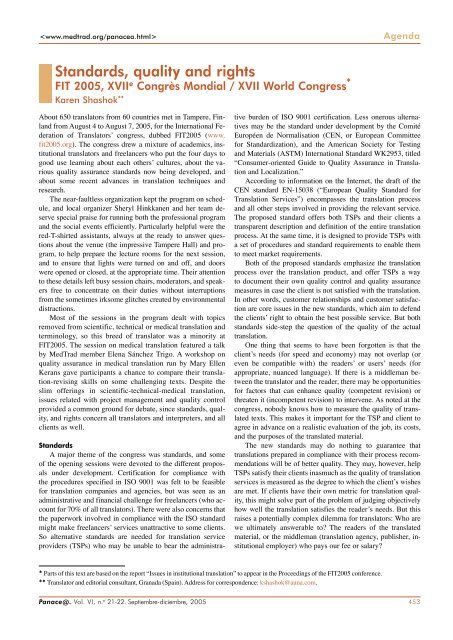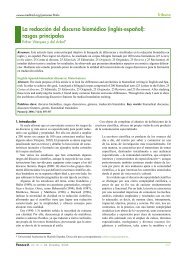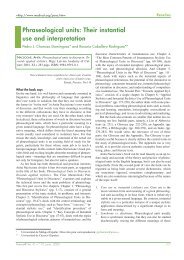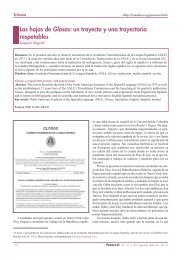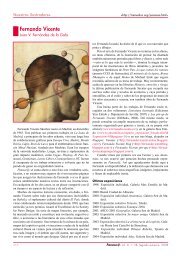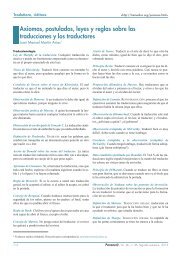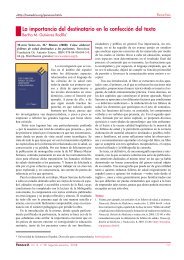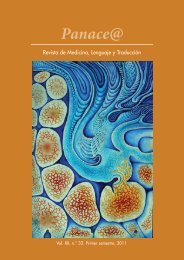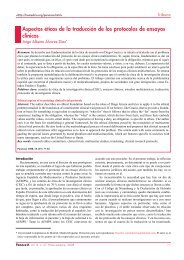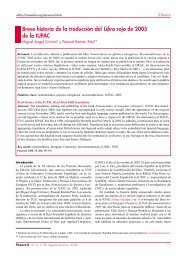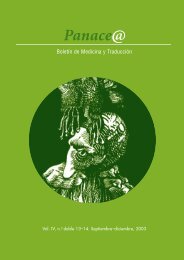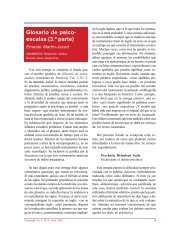Create successful ePaper yourself
Turn your PDF publications into a flip-book with our unique Google optimized e-Paper software.
Agenda<br />
Standards, quality and rights<br />
FIT 2005, XVII e Congrès Mondial / XVII World Congress *<br />
Karen Shashok **<br />
About 650 translators from 60 countries met in Tampere, Finland<br />
from August 4 to August 7, 2005, for the International Federation<br />
of Translators’ congress, dubbed FIT2005 (www.<br />
fit2005.org). The congress drew a mixture of academics, institutional<br />
translators and freelancers who put the four days to<br />
good use learning about each others’ cultures, about the various<br />
quality assurance standards now being developed, and<br />
about some recent advances in translation techniques and<br />
research.<br />
The near-faultless organization kept the program on schedule,<br />
and local organizer Sheryl Hinkkanen and her team deserve<br />
special praise for running both the professional program<br />
and the social events efficiently. Particularly helpful were the<br />
red-T-shirted assistants, always at the ready to answer questions<br />
about the venue (the impressive Tampere Hall) and program,<br />
to help prepare the lecture rooms for the next session,<br />
and to ensure that lights were turned on and off, and doors<br />
were opened or closed, at the appropriate time. Their attention<br />
to these details left busy session chairs, moderators, and speakers<br />
free to concentrate on their duties without interruptions<br />
from the sometimes irksome glitches created by environmental<br />
distractions.<br />
Most of the sessions in the program dealt with topics<br />
removed from scientific, technical or medical translation and<br />
terminology, so this breed of translator was a minority at<br />
FIT2005. The session on medical translation featured a talk<br />
by MedTrad member Elena Sánchez Trigo. A workshop on<br />
quality assurance in medical translation run by Mary Ellen<br />
Kerans gave participants a chance to compare their translation-revising<br />
skills on some challenging texts. Despite the<br />
slim offerings in scientific-technical-medical translation,<br />
issues related with project management and quality control<br />
provided a common ground for debate, since standards, quality,<br />
and rights concern all translators and interpreters, and all<br />
clients as well.<br />
Standards<br />
A major theme of the congress was standards, and some<br />
of the opening sessions were devoted to the different proposals<br />
under development. Certification for compliance with<br />
the procedures specified in ISO 9001 was felt to be feasible<br />
for translation companies and agencies, but was seen as an<br />
administrative and financial challenge for freelancers (who account<br />
for 70% of all translators). There were also concerns that<br />
the paperwork involved in compliance with the ISO standard<br />
might make freelancers’ services unattractive to some clients.<br />
So alternative standards are needed for translation service<br />
providers (TSPs) who may be unable to bear the administra-<br />
tive burden of ISO 9001 certification. Less onerous alternatives<br />
may be the standard under development by the Comité<br />
Européen de Normalisation (CEN, or European Committee<br />
for Standardization), and the American Society for Testing<br />
and Materials (ASTM) International Standard WK2953, titled<br />
“Consumer-oriented Guide to Quality Assurance in Translation<br />
and Localization.”<br />
According to information on the Internet, the draft of the<br />
CEN standard EN-15038 (“European Quality Standard for<br />
Translation Services”) encompasses the translation process<br />
and all other steps involved in providing the relevant service.<br />
The proposed standard offers both TSPs and their clients a<br />
transparent description and definition of the entire translation<br />
process. At the same time, it is designed to provide TSPs with<br />
a set of procedures and standard requirements to enable them<br />
to meet market requirements.<br />
Both of the proposed standards emphasize the translation<br />
process over the translation product, and offer TSPs a way<br />
to document their own quality control and quality assurance<br />
measures in case the client is not satisfied with the translation.<br />
In other words, customer relationships and customer satisfaction<br />
are core issues in the new standards, which aim to defend<br />
the clients’ right to obtain the best possible service. But both<br />
standards side-step the question of the quality of the actual<br />
translation.<br />
One thing that seems to have been forgotten is that the<br />
client’s needs (for speed and economy) may not overlap (or<br />
even be compatible with) the readers’ or users’ needs (for<br />
appropriate, nuanced language). If there is a middleman between<br />
the translator and the reader, there may be opportunities<br />
for factors that can enhance quality (competent revision) or<br />
threaten it (incompetent revision) to intervene. As noted at the<br />
congress, nobody knows how to measure the quality of translated<br />
texts. This makes it important for the TSP and client to<br />
agree in advance on a realistic evaluation of the job, its costs,<br />
and the purposes of the translated material.<br />
The new standards may do nothing to guarantee that<br />
translations prepared in compliance with their process recommendations<br />
will be of better quality. They may, however, help<br />
TSPs satisfy their clients inasmuch as the quality of translation<br />
services is measured as the degree to which the client’s wishes<br />
are met. If clients have their own metric for translation quality,<br />
this might solve part of the problem of judging objectively<br />
how well the translation satisfies the reader’s needs. But this<br />
raises a potentially complex dilemma for translators: Who are<br />
we ultimately answerable to? The readers of the translated<br />
material, or the middleman (translation agency, publisher, institutional<br />
employer) who pays our fee or salary?<br />
* Parts of this text are based on the report “Issues in institutional translation” to appear in the Proceedings of the FIT2005 conference.<br />
** Translator and editorial consultant, Granada (Spain). Address for correspondence: kshashok@auna.com.<br />
Panace@. Vol. VI, n. o 21-22. Septiembre-diciembre, 2005 453


